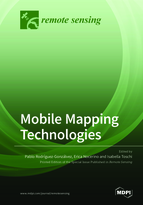Mobile Mapping Technologies
A special issue of Remote Sensing (ISSN 2072-4292).
Deadline for manuscript submissions: closed (31 August 2019) | Viewed by 76618
Special Issue Editors
Interests: photogrammetry; drones; laser scanning; radiometric calibration; remote sensing; RGB-D sensors; 3D modeling; mobile mapping; metrology; verification; inspection; quality control
Special Issues, Collections and Topics in MDPI journals
Interests: underwater photogrammetry; quality assessment; system calibration; 3D surveying and mapping
Special Issues, Collections and Topics in MDPI journals
Interests: photogrammetry; laser scanning; airborne mapping; 3D modelling; calibration; mobile mapping systems
Special Issues, Collections and Topics in MDPI journals
Interests: inertial navigation system; optimal multi-sensor fusion; seamless mapping and navigation applications; artificial intelligence and collaborative mobile mapping technology
Special Issues, Collections and Topics in MDPI journals
Special Issue Information
Dear Colleagues,
Mobile mapping technologies have seen a rapid growth of research activity and interest in the last years, due to the increased demand for accurate, dense and geo-referenced 3D data. Their main characteristic is the ability to acquire 3D information for large areas dynamically. This versatility has expanded their application fields from civil engineering to a broad range of fields (industry, emergency response, cultural heritage...), which is still widening. This increased number of needs, some of them especially challenging, is pushing the scientific community, as well as companies, to propose innovative solutions, ranging from new hardware/open source software approaches and integration with other devices, to the adoption and development of artificial intelligence methods for the automatic extraction of salient features and quality assessments for performance verification
The aim of the present Special Issue is to cover the relevant topics and trends in mobile mapping technology, and also to introduce the new tendencies of this new paradigm in geospatial science.
We would like to invite you to contribute by submitting articles describing your recent research, experimental work, reviews and/or case studies related to the field of mobile mapping. Contributions may be from, but not limited to, the following topics:
- Sensor design and platform developments.
- Geometric calibration.
- Radiometry: calibration and texturing.
- Multi-source data fusion.
- Hybridization with other data sources.
- Simultaneous localization and mapping.
- Low-cost solutions.
- Portable mobile mapping systems.
- Point cloud processing.
- Feature extraction.
- Machine learning.
- Deep learning.
- Accuracy, precision and quality assessment.
- Verification and validation.
- Indoor mapping and navigation.
- Autonomous navigation.
- GNSS-denied environments.
- Urban analysis.
- Forest mapping.
- Post-disaster assessment.
- Novel application cases.
Dr. Pablo Rodríguez-Gonzálvez
Dr. Erica Nocerino
Dr. Isabella Toschi
Prof. Dr. Kai-Wei Chiang
Guest Editors
Manuscript Submission Information
Manuscripts should be submitted online at www.mdpi.com by registering and logging in to this website. Once you are registered, click here to go to the submission form. Manuscripts can be submitted until the deadline. All submissions that pass pre-check are peer-reviewed. Accepted papers will be published continuously in the journal (as soon as accepted) and will be listed together on the special issue website. Research articles, review articles as well as short communications are invited. For planned papers, a title and short abstract (about 100 words) can be sent to the Editorial Office for announcement on this website.
Submitted manuscripts should not have been published previously, nor be under consideration for publication elsewhere (except conference proceedings papers). All manuscripts are thoroughly refereed through a single-blind peer-review process. A guide for authors and other relevant information for submission of manuscripts is available on the Instructions for Authors page. Remote Sensing is an international peer-reviewed open access semimonthly journal published by MDPI.
Please visit the Instructions for Authors page before submitting a manuscript. The Article Processing Charge (APC) for publication in this open access journal is 2700 CHF (Swiss Francs). Submitted papers should be well formatted and use good English. Authors may use MDPI's English editing service prior to publication or during author revisions.
Keywords
- Mobile laser scanning
- Portable mobile mapping systems
- Calibration
- Airborne laser scanning
- Data fusion
- Sensor integration
- Feature extraction
- 3D modelling
- Georeferencing
- Verification and validation
- Accuracy and precision assessment








